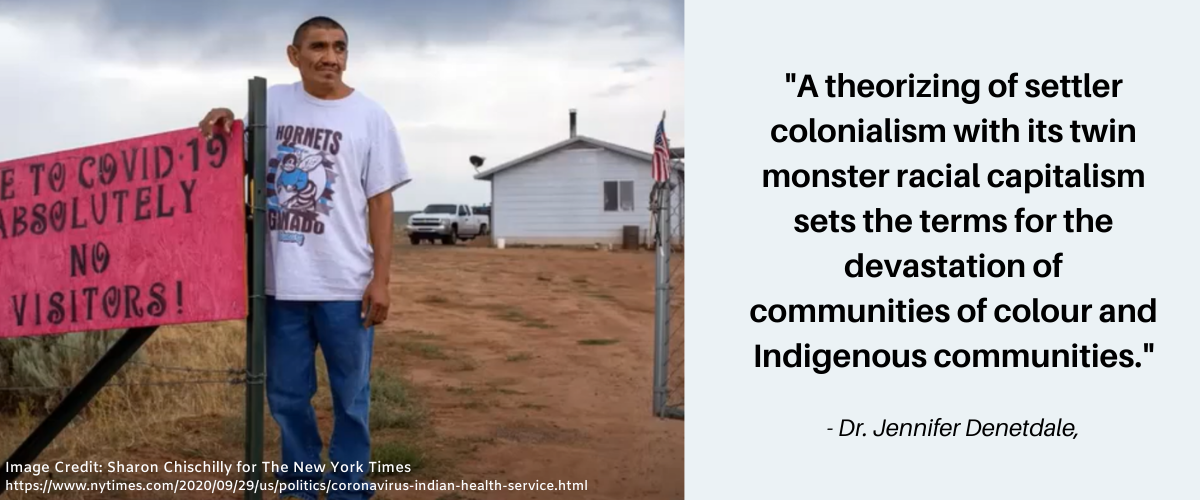Recap of Keynote Presentation by Dr. Jennifer Denetdale
Keynote speaker Dr. Jennifer Denetdale delivered a moving presentation of her research findings at the Kana Wain Dida International Gathering this May. As a professor of American Studies at the University of New Mexico and the chair of the Navajo Nation Human Rights Commission, her work examines the impacts of COVID-19 on the Diné. She studied the spread of the virus across the Navajo Nation, and the systemic and institutional failures that enabled it.
The Navajo Nation is located in southwestern United States, and has the largest land base of any Native nation in the country. In March of 2020, the Navajo Nation grabbed the attention of international media when a Navajo man tested positive for COVID-19. He had recently returned from Chilchinbeto, Arizona, where Navajos had gathered for a Nazarene Zones rally. In just over two months, the rate of COVID-19 cases on the Navajo Nation surpassed all other American states, including New York. Now, Dr. Denetdale says that everyone she knows has lost someone to the disease, or knows of families who have.
The disproportionate effects of COVID-19 on communities of colour has become a recognized reality. Dr. Denetdale explains that discussions of this reality are often “tainted with economic elitism as we participate in or witness the rebuking of people of color who cannot seem to stay home.” Dr. Denetdale says that often, Navajo people do not have the luxury to work from home, and that they live in multigenerational households “not because it is traditional, but because it’s almost impossible for Navajos to build a home on Navajo land.” Adequate housing is severely limited by poverty and antiquated land use policies.
Housing is not the only thing transforming the virus into a “weapon for white supremacy,” as labelled by Dr. Denetdale. The risks associated with COVID-19 are increased significantly by pre-existing health conditions. Higher rates of cancer, diabetes, alcoholism, and suicide ー brought on by the living history of boarding schools, resource extraction, and the loss of their traditional lifestyle ー make the Navajo people more susceptible to the virus. In addition, at least forty percent of households in the nation do not have access to clean, running water. This forces a continuous migration to and from the surrounding towns and contributes to the spread of the virus.

The Navajo Nation did not always depend on outside sources for food, water, and resources. Their movement away from self-subsistence was led by the United States Commissioner of Indian Affairs John Collier, who ordered the removal of half of Navajo-owned horses, sheeps and goats, citing concerns that they were overgrazing. At the same time, Navajo resources were extracted to fuel the expansion of urban areas in the southwestern United States. This transition to a wage economy and targeting of natural resources created the deadly lack of infrastructure that exacerbated the effects of COVID-19. The failed government response to the pandemic was unleashed on Diné communities. They quickly became hotspots because the conditions under which their people live, ones of poverty and economic disparity, are the same conditions that increase the rates of infection and death.
Denetdale also mentioned that throughout the pandemic, “there has been this sense of loss and despair. There’s been this sense of nostalgia, about mourning for the past, mourning for a time before COVID.” But after highlighting this collective sense of longing, she asked us why we grieve. Why do we want to return to a world before COVID-19, where Indigenous people suffered under colonial institutions, where Indigenous women and girls were Missing and Murdered, and where police violence against people of colour would soon bring young Diné to march in solidarity with the international Black Lives Matter movement?
As Denetdale said, “For the Navajo people, COVID-19 is one of the many monsters of the old stories.” In the face of such monsters, her people have stayed strong through K’é, meaning kinship, a complex and sophisticated code of ethics that governs their care for each other, the land, their livestock, and their relationship to the universe. This has been shown through the establishment of mutual aid organizations, including the Navajo & Hopi Families COVID-19 Relief Fund, which offer support for those struggling under the pandemic. Denetdale also hopes to reconnect Diné to their land and traditional practices:
“The counter to the devastation to death is iiná, life, and its persistence through relationships that extend to the natural world and all beings. Through our relationships, we will revitalize our communities.”
At the time of her presentation, the Navajo Nation had begun the process of reopening. They were reporting high rates of vaccination among their people, which is no small accomplishment. For Denetdale, her two doses required a combined 480 miles of driving. On March 23, 2021, they reported no new cases or deaths for the first time this year.
If you missed Dr. Denetdale’s presentation at the Kana Wain Dida International Gathering, or if you would like to watch it again, it will soon be available here on our website (covid19indigenous.ca).
